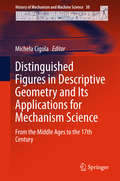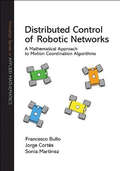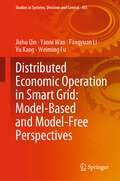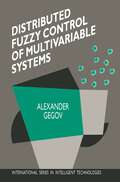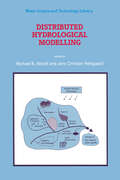- Table View
- List View
Distant Connections: The Memory Basis of Creative Analogy (SpringerBriefs in Psychology)
by Máximo Trench Ricardo A. MinervinoAnalogical thinking lies at the core of human cognition, pervading from the most mundane to the most extraordinary forms of creativity. By connecting poorly understood phenomena to learned situations whose structure is well articulated, it allows reasoners to expand the boundaries of their knowledge. The first part of the book begins by fleshing out the debate around whether our cognitive system is well-suited for creative analogizing, and ends by reviewing a series of studies that were designed to decide between the experimental and the naturalistic accounts. The studies confirm the psychological reality of the surface bias revealed by most experimental studies, thus claiming for realistic solutions to the problem of inert knowledge. The second part of the book delves into cognitive interventions, while maintaining an emphasis on the interplay between psychological modeling and instructional applications. It begins by reviewing the first generation of instructional interventions aimed at improving the later retrievability of educational contents by highlighting their abstract structure. Subsequent chapters discuss the most realistic avenues for devising easily-executable and widely-applicable ways of enhancing access to stored knowledge that would otherwise remain inert. The authors review results from studies from both others and their own lab that speak of the promise of these approaches.
Distinguished Figures in Descriptive Geometry and Its Applications for Mechanism Science: From the Middle Ages to the 17th Century (History of Mechanism and Machine Science #30)
by Michela CigolaThis book consists of chapters that focus specifically on single figures that worked on Descriptive Geometry and also in Mechanisms Sciences and contain biographical notes, a survey of their work and their achievements, together with a modern interpretation of their legacy.Since Vitruvius in ancient times, and with Brunelleschi in the Renaissance, the two disciplines began to share a common direction which, over the centuries, took shape through less well-known figures until the more recent times in which Gaspard Monge worked.Over the years, a gap has been created between Descriptive Geometry and Mechanism Science, which now appear to belong to different worlds. In reality, however, there is a very close relationship between the two disciplines, with a link based on extremely solid foundations. Without the theoretical foundations of Geometry it would not be possible to draw and design mechanical parts such as gears, while in Kinematics it would be less easy to design and predict the reciprocal movements of parts in a complex mechanical assembly.
Distortion Theorems in Relation to Linear Integral Operators (Mathematics and Its Applications #385)
by Y. KomatuThe present monograph consists of two parts. Before Part I, a chapter of introduction is supplemented, where an overview of the whole volume is given for reader's convenience. The former part is devoted mainly to expose linear inte gral operators introduced by the author. Several properties of the operators are established, and specializations as well as generalizations are attempted variously in order to make use them in the latter part. As compared with the former part, the latter part is de voted mainly to develop several kinds of distortions under actions of integral operators for various familiar function also absolute modulus. real part. range. length and area. an gular derivative, etc. Besides them, distortions on the class of univalent functions and its subclasses, Caratheodory class as well as distortions by a differential operator are dealt with. Related differential operators play also active roles. Many illustrative examples will be inserted in order to help understanding of the general statements. The basic materials in this monograph are taken from a series of researches performed by the author himself chiefly in the past two decades. While the themes of the papers pub lished hitherto are necessarily not arranged chronologically Preface viii and systematically, the author makes here an effort to ar range them as ,orderly as possible. In attaching the import ance of the self-containedness to the book, some of unfamil iar subjects will also be inserted and, moreover, be wholly accompanied by their respective proofs, though unrelated they may be.
Distributed Artificial Intelligence: Second International Conference, DAI 2020, Nanjing, China, October 24–27, 2020, Proceedings (Lecture Notes in Computer Science #12547)
by Matthew E. Taylor Yang Yu Edith Elkind Yang GaoThis book constitutes the refereed proceedings of the Second International Conference on Distributed Artificial Intelligence, DAI 2020, held in Nanjing, China, in October 2020. The 9 full papers presented in this book were carefully reviewed and selected from 22 submissions. DAI aims at bringing together international researchers and practitioners in related areas including general AI, multiagent systems, distributed learning, computational game theory, etc., to provide a single, high-profile, internationally renowned forum for research in the theory and practice of distributed AI. Due to the Corona pandemic this event was held virtually.
Distributed Computer and Communication Networks: 20th International Conference, DCCN 2017, Moscow, Russia, September 25–29, 2017, Proceedings (Communications in Computer and Information Science #700)
by Vladimir M. Vishnevskiy Konstantin E. Samouylov Dmitry V. KozyrevThis book constitutes the refereed proceedings of the 20th International Conference on Distributed and Computer and Communication Networks, DCCN 2017, held in Moscow, Russia, in September 2017.The 39 full papers and the two short papers were carefully reviewed and selected from 176 submissions. The papers cover the following topics: computer and communication networks architecture optimization; control in computer and communication networks; performance and QoS/QoE evaluation in wireless networks; analytical modeling and simulation of next-generation communications systems; queueing theory and reliability theory applications in computer networks; wireless 4G/5G networks, cm- and mm-wave radio technologies; RFID technology and its application in intellectual transportation networks; Internet of Things, wearables, and applications of distributed information systems; probabilistic and statistical models in information systems; mathematical modeling of high-tech systems; mathematical modeling and control problems; distributed and cloud computing systems, big data analytics.
Distributed Computer and Communication Networks: 19th International Conference, DCCN 2016, Moscow, Russia, November 21-25, 2016, Revised Selected Papers (Communications in Computer and Information Science #678)
by Vladimir M. Vishnevskiy Konstantin E. Samouylov Dmitry V. KozyrevThis book constitutes the refereed proceedings of the 19th International Conference on Distributed and Computer and Communication Networks, DCCN 2016, held in Moscow, Russia, in November 2016. The 50 revised full papers and the 6 revised short papers presented were carefully reviewed and selected from 141 submissions. The papers cover the following topics: computer and communication networks architecture optimization; control in computer and communication networks; performance and QoS/QoE evaluation in wireless networks; analytical modeling and simulation of next-generation communications systems; queuing theory and reliability theory applications in computer networks; wireless 4G/5G networks, cm- and mm-wave radio technologies; RFID technology and its application in intellectual transportation networks; internet of things, wearables, and applications of distributed information systems; probabilistic and statistical models in information systems; mathematical modeling of high-tech systems; mathematical modeling and control problems; distributed and cloud computing systems, big data analytics.
Distributed Computer and Communication Networks: 22nd International Conference, DCCN 2019, Moscow, Russia, September 23–27, 2019, Revised Selected Papers (Communications in Computer and Information Science #1141)
by Vladimir M. Vishnevskiy Konstantin E. Samouylov Dmitry V. KozyrevThis book constitutes the refereed proceedings of the 22nd International Conference on Distributed and Computer and Communication Networks, DCCN 2019, held in Moscow, Russia, in September 2019. The 50 full papers and 2 short papers were carefully reviewed and selected from 174 submissions. The papers cover the following topics: Computer and Communication Networks and Technologies, Analytical Modeling of Distributed Systems, and Distributed Systems Applications.
Distributed Computer and Communication Networks: 22nd International Conference, DCCN 2019, Moscow, Russia, September 23–27, 2019, Revised Selected Papers (Lecture Notes in Computer Science #11965)
by Vladimir M. Vishnevskiy Konstantin E. Samouylov Dmitry V. KozyrevThis book constitutes the refereed proceedings of the 22nd International Conference on Distributed and Computer and Communication Networks, DCCN 2019, held in Moscow, Russia, in September 2019. The 44 full papers and 2 short papers were carefully reviewed and selected from 174 submissions. The papers cover the following topics: Computer and Communication Networks, Analytical Modeling of Distributed Systems, and Distributed Systems Applications.
Distributed Computer and Communication Networks: 25th International Conference, Dccn 2022, Moscow, Russia, September 26-29, 2022, Revised Selected Papers (Lecture Notes In Computer Science Ser. #13766)
by Vladimir M. Vishnevskiy Konstantin E. Samouylov Dmitry V. KozyrevDistributed Computer and Communication Networks: 26th International Conference, DCCN 2023, Moscow, Russia, September 25–29, 2023, Revised Selected Papers (Lecture Notes in Computer Science #14123)
by Vladimir M. Vishnevskiy Konstantin E. Samouylov Dmitry V. KozyrevThis book constitutes the refereed proceedings of the 26th International Conference on Distributed Computer and Communication Networks: Control, Computation, Communications, DCCN 2023, held in Moscow, Russia, during September 25–29, 2023. The 37 full papers and 4 short papers included in this book were carefully reviewed and selected from 122 submissions. They were organized in topical sections as follows: Distributed Systems Applications; Analytical Modeling of Distributed Systems; Computer and Communication Networks.
Distributed Computer and Communication Networks: 26th International Conference, DCCN 2023, Moscow, Russia, September 25–29, 2023, Revised Selected Papers (Communications in Computer and Information Science #2129)
by Vladimir M. Vishnevskiy Konstantin E. Samouylov Dmitry V. KozyrevThe proceedings constitute papers presented in the 26th International Conference, DCCN 2023, held in Moscow, Russia, during September 25–29, 2023. The 8 full papers were carefully reviewed and selected from 122 submissions. They cover variety of topics including networks architecture, network protocols, distributed computer systems, distributed communication systems, simulation, stochastic processes, queueing and reliability theory, Internet and web applications and services, wireless networks, Internet of things, performance analysis, and high-altitude communication platforms.
Distributed Computer and Communication Networks: 18th International Conference, DCCN 2015, Moscow, Russia, October 19-22, 2015, Revised Selected Papers (Communications in Computer and Information Science #601)
by Vladimir Vishnevsky Dmitry KozyrevThis book constitutes the refereed proceedings of the 18th International Conference on Distributed and Computer and Communication Networks, DCCN 2015, held in Moscow, Russia, in October 2015. The 38 revised full papers presented were carefully reviewed and selected from 94 submissions. The papers cover the following topics: computer and communication networks architecture optimization; control in computer and communication networks; performance and QoS evaluation in wireless networks; modeling and simulation of network protocols; queuing and reliability theory; wireless IEEE 802.11, IEEE 802.15, IEEE 802.16, and UMTS (LTE) networks; FRID technology and its application in intellectual transportation networks; protocols design (MAC, Routing) for centimeter and millimeter wave mesh networks; internet and web applications and services; application integration in distributed information systems; big data in communication networks.
Distributed Computer and Communication Networks: 17th International Conference, DCCN 2013, Moscow, Russia, October 7-10, 2013. Revised Selected Papers (Communications in Computer and Information Science #279)
by Vladimir Vishnevsky, Dmitry Kozyrev and Andrey LarionovThis book constitutes the refereed proceedings of the 17th International Conference on Distributed Computer and Communication Networks, DCCN 2013, held in Moscow, Russia, in October 2013. The 22 revised full papers presented were carefully reviewed and selected from numerous submissions. The papers cover the following subjects: computer and communication networks architecture optimization; control in computer and communication networks; performance and QoS evaluation in wireless networks; modeling and simulation of network protocols; queueing theory; wireless IEEE 802.11, IEEE 802.15, IEEE 802.16 and UMTS (LTE) net-works; RFID technology and its application in intellectual transportation networks; protocols design (MAC, Routing) for centimeter and millimeter wave mesh networks; internet and web applications and services; application integration in distributed information systems.
Distributed Computing and Optimization Techniques: Select Proceedings of ICDCOT 2021 (Lecture Notes in Electrical Engineering #903)
by Sudhan Majhi Rocío Pérez de Prado Chandrappa Dasanapura NanjundaiahThis book introduces research presented at the International Conference on Distributed Computing and Optimization Techniques (ICDCOT–2021), a two-day conference, where researchers, engineers, and academicians from all over the world came together to share their experiences and findings on all aspects of distributed computing and its applications in diverse areas. The book includes papers on distributed computing, intelligent system, optimization method, mathematical modeling, fuzzy logic, neural networks, grid computing, load balancing, communication. It will be a valuable resource for students, academics, and practitioners in the industry working on distributed computing.
Distributed Computing Through Combinatorial Topology
by Sergio Rajsbaum Maurice Herlihy Dmitry KozlovDistributed Computing Through Combinatorial Topology describes techniques for analyzing distributed algorithms based on award winning combinatorial topology research. The authors present a solid theoretical foundation relevant to many real systems reliant on parallelism with unpredictable delays, such as multicore microprocessors, wireless networks, distributed systems, and Internet protocols. Today, a new student or researcher must assemble a collection of scattered conference publications, which are typically terse and commonly use different notations and terminologies. This book provides a self-contained explanation of the mathematics to readers with computer science backgrounds, as well as explaining computer science concepts to readers with backgrounds in applied mathematics. The first section presents mathematical notions and models, including message passing and shared-memory systems, failures, and timing models. The next section presents core concepts in two chapters each: first, proving a simple result that lends itself to examples and pictures that will build up readers' intuition; then generalizing the concept to prove a more sophisticated result. The overall result weaves together and develops the basic concepts of the field, presenting them in a gradual and intuitively appealing way. The book's final section discusses advanced topics typically found in a graduate-level course for those who wish to explore further. Named a 2013 Notable Computer Book for Computing Methodologies by Computing ReviewsGathers knowledge otherwise spread across research and conference papers using consistent notations and a standard approach to facilitate understandingPresents unique insights applicable to multiple computing fields, including multicore microprocessors, wireless networks, distributed systems, and Internet protocols Synthesizes and distills material into a simple, unified presentation with examples, illustrations, and exercises
Distributed Control and Optimization of Networked Microgrids: A Multi-Agent System Based Approach (Power Systems)
by Qing-Long Han Boda Ning Lei DingThis book presents new techniques and methods for distributed control and optimization of networked microgrids. Distributed consensus issues under network-based and event-triggered mechanisms are first addressed in a multi-agent system framework, which can explicitly characterize the relationship between communication resources and the control performance. Then, considering the effects of network uncertainties, multi-agent system-based distributed schemes are tailored to solve the fundamental issues of networked microgrids such as distributed frequency regulation, voltage regulation, active power sharing/load sharing, and energy management. The monograph will contribute to stimulating extensive interest of researchers in electrical and control fields.
Distributed Control of Robotic Networks: A Mathematical Approach to Motion Coordination Algorithms (PDF)
by Francesco Bullo Jorge Cortés Sonia MartínezThis self-contained introduction to the distributed control of robotic networks offers a distinctive blend of computer science and control theory. The book presents a broad set of tools for understanding coordination algorithms, determining their correctness, and assessing their complexity; and it analyzes various cooperative strategies for tasks such as consensus, rendezvous, connectivity maintenance, deployment, and boundary estimation. The unifying theme is a formal model for robotic networks that explicitly incorporates their communication, sensing, control, and processing capabilities--a model that in turn leads to a common formal language to describe and analyze coordination algorithms. Written for first- and second-year graduate students in control and robotics, the book will also be useful to researchers in control theory, robotics, distributed algorithms, and automata theory. The book provides explanations of the basic concepts and main results, as well as numerous examples and exercises. Self-contained exposition of graph-theoretic concepts, distributed algorithms, and complexity measures for processor networks with fixed interconnection topology and for robotic networks with position-dependent interconnection topology Detailed treatment of averaging and consensus algorithms interpreted as linear iterations on synchronous networks Introduction of geometric notions such as partitions, proximity graphs, and multicenter functions Detailed treatment of motion coordination algorithms for deployment, rendezvous, connectivity maintenance, and boundary estimation
Distributed Decision Making and Control (Lecture Notes in Control and Information Sciences #417)
by Rolf Johansson Anders RantzerDistributed Decision Making and Control is a mathematical treatment of relevant problems in distributed control, decision and multiagent systems, The research reported was prompted by the recent rapid development in large-scale networked and embedded systems and communications. One of the main reasons for the growing complexity in such systems is the dynamics introduced by computation and communication delays. Reliability, predictability, and efficient utilization of processing power and network resources are central issues and the new theory and design methods presented here are needed to analyze and optimize the complex interactions that arise between controllers, plants and networks. The text also helps to meet requirements arising from industrial practice for a more systematic approach to the design of distributed control structures and corresponding information interfaces Theory for coordination of many different control units is closely related to economics and game theory network uses being dictated by congestion-based pricing of a given pathway. The text extends existing methods which represent pricing mechanisms as Lagrange multipliers to distributed optimization in a dynamic setting. In Distributed Decision Making and Control, the main theme is distributed decision making and control with contributions to a general theory and methodology for control of complex engineering systems in engineering, economics and logistics. This includes scalable methods and tools for modeling, analysis and control synthesis, as well as reliable implementations using networked embedded systems. Academic researchers and graduate students in control science, system theory, and mathematical economics and logistics will find mcu to interest them in this collection, first presented orally by the contributors during a sequence of workshops organized in Spring 2010 by the Lund Center for Control of Complex Engineering Systems, a Linnaeus Center at Lund University, Sweden.>
Distributed Denial of Service Attacks: Real-world Detection and Mitigation
by İlker Özçelik Richard BrooksDistributed Denial of Service (DDoS) attacks have become more destructive, wide-spread and harder to control over time. This book allows students to understand how these attacks are constructed, the security flaws they leverage, why they are effective, how they can be detected, and how they can be mitigated. Students use software defined networking (SDN) technology to created and execute controlled DDoS experiments. They learn how to deploy networks, analyze network performance, and create resilient systems. This book is used for graduate level computer engineering instruction at Clemson University. It augments the traditional graduate computing curricula by integrating: Internet deployment, network security, ethics, contemporary social issues, and engineering principles into a laboratory based course of instruction. Unique features of this book include: A history of DDoS attacks that includes attacker motivations Discussion of cyber-war, censorship, and Internet black-outs SDN based DDoS laboratory assignments Up-to-date review of current DDoS attack techniques and tools Review of the current laws that globally relate to DDoS Abuse of DNS, NTP, BGP and other parts of the global Internet infrastructure to attack networks Mathematics of Internet traffic measurement Game theory for DDoS resilience Construction of content distribution systems that absorb DDoS attacks This book assumes familiarity with computing, Internet design, appropriate background in mathematics, and some programming skills. It provides analysis and reference material for networking engineers and researchers. By increasing student knowledge in security, and networking; it adds breadth and depth to advanced computing curricula.
Distributed Denial of Service Attacks: Real-world Detection and Mitigation
by İlker Özçelik Richard BrooksDistributed Denial of Service (DDoS) attacks have become more destructive, wide-spread and harder to control over time. This book allows students to understand how these attacks are constructed, the security flaws they leverage, why they are effective, how they can be detected, and how they can be mitigated. Students use software defined networking (SDN) technology to created and execute controlled DDoS experiments. They learn how to deploy networks, analyze network performance, and create resilient systems. This book is used for graduate level computer engineering instruction at Clemson University. It augments the traditional graduate computing curricula by integrating: Internet deployment, network security, ethics, contemporary social issues, and engineering principles into a laboratory based course of instruction. Unique features of this book include: A history of DDoS attacks that includes attacker motivations Discussion of cyber-war, censorship, and Internet black-outs SDN based DDoS laboratory assignments Up-to-date review of current DDoS attack techniques and tools Review of the current laws that globally relate to DDoS Abuse of DNS, NTP, BGP and other parts of the global Internet infrastructure to attack networks Mathematics of Internet traffic measurement Game theory for DDoS resilience Construction of content distribution systems that absorb DDoS attacks This book assumes familiarity with computing, Internet design, appropriate background in mathematics, and some programming skills. It provides analysis and reference material for networking engineers and researchers. By increasing student knowledge in security, and networking; it adds breadth and depth to advanced computing curricula.
Distributed Economic Operation in Smart Grid: Model-Based and Model-Free Perspectives (Studies in Systems, Decision and Control #455)
by Jiahu Qin Yanni Wan Fangyuan Li Yu Kang Weiming FuThis book aims to work out the distributed economic operation in smart grids in a systematic way, which ranges from model-based to model-free perspectives. The main contributions of this book can be summarized into three folds. First, we investigate the fundamental economic operation problems in smart grids from model-based perspective. Specifically, these problems can be modeled as deterministic optimization models, and we propose some distributed optimization algorithms by integrating the multi-agent consensus theory and optimization techniques to achieve the distributed coordination of various generation units and loads. Second, due to the randomness of the large-scale renewable energies and the flexibility of the loads, we further address these economic operation problems from a model-free perspective, and we propose learning-based approaches to address the uncertainty and randomness. At last, we extend the idea of model-based and model-free algorithms to plug-in electric vehicles (PEVs) charging/discharging scheduling problem, the key challenge of which involves multiple objectives simultaneously while the behavior of PEVs and the electricity price are intrinsically random. This book presents several recent theoretical findings on distributed economic operation in smart grids from model-based and model-free perspectives. By systematically integrating novel ideas, fresh insights, and rigorous results, this book provides a base for further theoretical research on distributed economic operation in smart grids. It can be a reference for graduates and researchers to study the operation and management in smart grids. Some prerequisites for reading this book include optimization theory, matrix theory, game theory, reinforcement learning, etc.
Distributed Filtering, Control and Synchronization: Local Performance Analysis Methods (Studies in Systems, Decision and Control #428)
by Fei Han Zidong Wang Hongli DongThis book establishes a unified framework for dealing with typical engineering complications arising in modern, complex, large-scale networks such as parameter uncertainties, missing measurement and cyber-attack. Distributed Filtering, Control and Synchronization is a timely reflection on methods designed to handle a series of control and signal-processing issues in modern industrial engineering practice in areas like power grids and environmental monitoring. It exploits the latest techniques to handle the emerging mathematical and computational challenges arising from, among other things, the dynamic topologies of distributed systems and in the context of sensor networks and multi-agent systems. These techniques include recursive linear matrix inequalities, local-performance and stochastic analyses and techniques based on matrix theory. Readers interested in the theory and application of control and signal processing will find much to interest them in the new models and methods presented in this book. Academic researchers can find ideas for developing their own research, graduate and advanced undergraduate students will be made aware of the state of the art, and practicing engineers will find methods for addressing practical difficulties besetting modern networked systems
Distributed Fuzzy Control of Multivariable Systems (International Series in Intelligent Technologies #6)
by Alexander GegovIt is known that many control processes are characterized by both quantitative and qualitative complexity. Tbe quantitative complexity is usually expressed in a large number of state variables, respectively high dimensional mathematical model. Tbe qualitative complexity is usually associated with uncertain behaviour, respectively approximately known mathematical model. If the above two aspects of complexity are considered separately, the corresponding control problem can be easily solved. On one hand, large scale systems theory has existed for more than 20 years and has proved its capabilities in solving high dimensional control problems on the basis of decomposition, hierarchy, decentralization and multilayers. On the other hand, the fuzzy linguistic approach is almost at the same age and has shown its advantages in solving approximately formulated control problems on the basis of linguistic reasoning and logical inference. However, if both aspects of complexity are considered together, the corresponding control problem becomes non-trivial and does not have an easy solution. Modem control theory and practice have reacted accordingly to the above mentioned new cballenges of tbe day by utilizing the latest achievements in computer technology and artificial intelligence distributed computation and intelligent operation. In this respect, a new field has emerged in the last decade, called " Distributed intelligent control systems" . However, the majority of the familiar works in this field are still either on an empirical or on a conceptual level and this is a significant drawback.
Distributed Hydrological Modelling (Water Science and Technology Library #22)
by Michael B. Abbott Jens Christian RefsgaardIt is the task of the engineer, as of any other professional person, to do everything that is reasonably possible to analyse the difficulties with which his or her client is confronted, and on this basis to design solutions and implement these in practice. The distributed hydrological model is, correspondingly, the means for doing everything that is reasonably possible - of mobilising as much data and testing it with as much knowledge as is economically feasible - for the purpose of analysing problems and of designing and implementing remedial measures in the case of difficulties arising within the hydrological cycle. Thus the aim of distributed hydrologic modelling is to make the fullest use of cartographic data, of geological data, of satellite data, of stream discharge measurements, of borehole data, of observations of crops and other vegetation, of historical records of floods and droughts, and indeed of everything else that has ever been recorded or remembered, and then to apply to this everything that is known about meteorology, plant physiology, soil physics, hydrogeology, sediment transport and everything else that is relevant within this context. Of course, no matter how much data we have and no matter how much we know, it will never be enough to treat some problems and some situations, but still we can aim in this way to do the best that we possibly can.
Distributed Large-Scale Dimensional Metrology: New Insights
by Fiorenzo Franceschini Maurizio Galetto Domenico Maisano Luca Mastrogiacomo Barbara PralioThe field of large-scale dimensional metrology (LSM) deals with objects that have linear dimensions ranging from tens to hundreds of meters. It has recently attracted a great deal of interest in many areas of production, including the automotive, railway, and shipbuilding sectors.Distributed Large-Scale Dimensional Metrology introduces a new paradigm in this field that reverses the classical metrological approach: measuring systems that are portable and can be easily moved around the location of the measured object, which is preferable to moving the object itself. Distributed Large-Scale Dimensional Metrology combines the concepts of distributed systems and large scale metrology at the application level. It focuses on the latest insights and challenges of this new generation of systems from the perspective of the designers and developers. The main topics are:coverage of measuring area,sensors calibration,on-line diagnostics,probe management, andanalysis of metrological performance.The general descriptions of each topic are further enriched by specific examples concerning the use of commercially available systems or the development of new prototypes. This will be particularly useful for professional practitioners such as quality engineers, manufacturing and development engineers, and procurement specialists, but Distributed Large-Scale Dimensional Metrology also has a wealth of information for interested academics.

